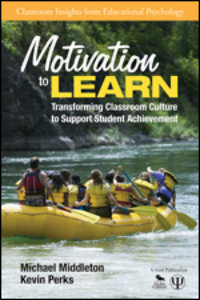A New Way to Think about Student Motivation
Motivation to Learn: Transforming Classroom Culture to Support Student Achievement
By Michael Middleton and Kevin Perks
(Corwin/SAGE Publications, 2014 – Learn more)

Have you ever had one of those days when you can’t figure out what more you can possibly do to motivate your students? If you have taught for any amount of time, you definitely know what I am talking about.
As a middle school teacher, I have felt on many days that my entire class period was spent struggling just to get students to actively engage and participate in the learning activity. Motivation to Learn: Transforming Classroom Culture to Support Student Achievement was made for moments like these. It is the perfect book to refresh a teacher’s understanding of the secrets to motivation.
Even better, this book doesn’t just talk about the theories behind motivating learners, but it also gives you concrete strategies for creating a classroom culture that maximizes student engagement. Whether you have been teaching for 25 years or just a couple, this book is the perfect balance of educational philosophy and practical ideas that can be implemented in your classroom immediately. Thank goodness!! Because I definitely do not need a book to waste my time.
A new metaphor for motivation

In this scenario, the teacher is the guide and the river is the curriculum. The students are rafters, navigating the ever changing waters. Thinking along these lines allows you to capture and recreate motivating moments, while steering clear of lessons that may hamper a student’s learning journey.
For example, a teacher can maximize student choice or spend focused time on building strong peer-to-peer relationships, while limiting activities that do not connect to the overall goals of the classroom.
Reflection and student feedback
In addition to reviewing the psychology behind motivation, the entire book asks teachers to consistently reflect on their own practice. A combination of surveys and short reflection activities are provided to help you better see your areas of strength and needs for improvement. There are even surveys that can be given to your students to solicit their feedback. How often do you take the time to gather the candid thoughts of your students?
The authors then encourage you to focus on weaker areas, using strategies from the book to build more engagement into your daily lessons. Using this reflective process, you will be better able to implement the provided motivational strategies.
The entire second half of the book is full of practical, useful activities that can be used right away to increase student motivation in your classroom.
How to read the book
One point to mention is that this book was difficult for me to read during the summer because of the amount of active reflection that was expected. There were several activities that required you to have a current class list or to think about one particular student. I would have found it more helpful to have read this book during the school year when I had students fresh in my mind.
This book would also work well for a book study. Being able to talk through passages and reflections adds a level of accountability that could better benefit students in the long run and help you sustain motivational strategies in your own classroom.
Tasha Kirby has taught grades 3-5, and most recently 7th grade science. She has focused on project-based and service learning activities throughout her career, leading groups of students to win national competitions, including Space Day, TOYchallenge, and Disney Planet Challenge. She has also been published in Science and Children and Green Teacher magazines. Her spare time is devoted to her own two children, Paige and Nash, hiking, camping, and visiting local parks.



































What a nice reveiw. Thank you Tasha!